|
Paphiopedilum x affine and Paphiopedilum gratrixianum var. christensonianum by Gary Yong Gee
Emile De Wildeman described Paph. affine De Wild. based upon plants thought to have come from Tonkin, Vietnam in 1906. The specific epithet comes from the Latin affinis (allied to) for the similarity to Paph. gratrixianum.
Since its description Paph.affine has been a much confused taxon. It has been regarded as a synonym of Paph. gratrixianum (Mast.) Guillaumin (Cribb, 1987) and also a naturally occurring hybrid of Paph. villosum and Paph. appletonianum (Cribb, 1998). Eric Christenson (2004) believed that many examples of Paph. affine had been masquerading as Paph. gratrixianum. He distinguished this taxon by the narrower more upright leaves and taller inflorescences.
In accordance with Cribb’s conclusion that Paph. x affine is a naturally-occurring hybrid, Holger Perner and Harold Koopowitz (2014) believed that the narrow-leaf variant was undescribed even though it has been in cultivation for about 40 years. They published Paph. gratrixianum var. christensonianum in Orchids in 2013. The varietal epithet honours Eric Christenson for recognising the long-lost typical variety of Paph. gratrixianum.
Paph. gratrixianum var. christensonianum can be distinguished from the typical Paph. gratrixianum by the narrower more upright leaves that are about 2 cm wide and tall inflorescences which hold the flowers well above the leaves. In addition, the flowers are usually smaller with a dorsal sepal that has stronger reflexed sides so as to appear narrower, particularly at the base.
Paph. gratrixianum var. christensonianum is a terrestrial sympodial lithophytic plant that often forms clumps with several growths, each consisting of 4-7 (-8) alternating, two-ranked suberect leaves. Between 25-30 cm long and 2-2.3 cm wide, the green leaves have purple spotting on the underside towards the base. Single-flowered, the green apical inflorescence is up to 25-45 cm long and covered with fine brownish-purple hairs.
Variable in colour, the flower of Paph. affine var. christensonianum is 7-8 (-9) cm across with a dorsal sepal that is pale green to yellow-green at the base and white above, and is spotted along the centre with bold raised maroon to purple spots in longitudinal lines. Sometimes the dorsal sepal may also be flushed with purple. The ventral sepal is pale green and the glossy pale greenish to yellow or ochre-coloured petals are flushed and veined with purplish brown. Its deeper greenish to yellow helmet-shaped lip is flushed brown.
Distributed in Vietnam and southern Laos, Paph. gratrixianum grows amongst humus on steep slopes of granite and other lime-free rocks in seasonally humid open woodland areas between 850-1,200 m altitude. Easy to grow and flower in the south-east Queensland region, Paph. gratrixianum var. christensonianum requires about 70% shade, a small pot with a well-drained medium, high humidity and good air circulation.
|
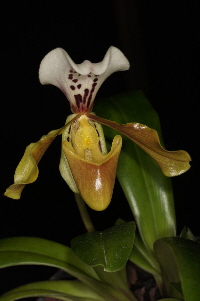
|
Paph. gratrixianum var. gratrixianum. Note the broad leaves and short flower stem.
|
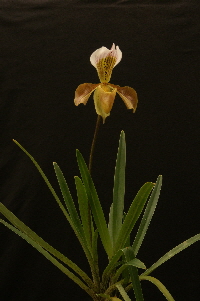
|
Paph. gratrixianum var. christensonianum. Note the more upright narrow leaves and tall flower stem.
|
|
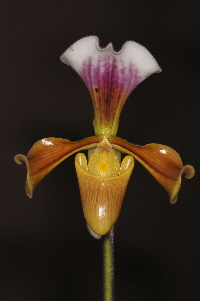
|
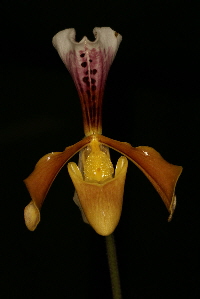
|
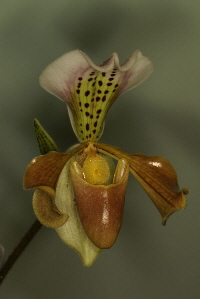
|
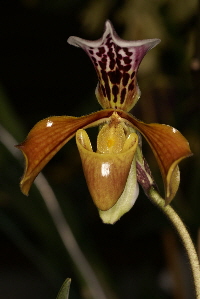
|
|
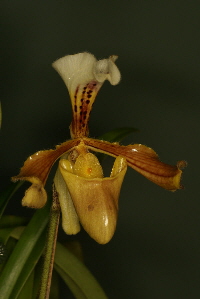
|
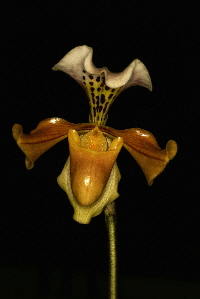
|
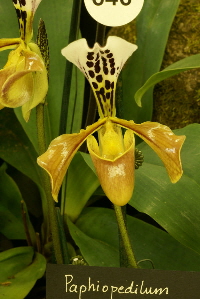
|
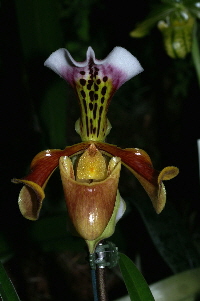
|
|
Paph. gratrixianum var. christensonianum. Note the colour variations particularly in the dorsal sepal. The amount of green to yellow at the base of the white dorsal varies as does the amount of red flushing. Also, note the variability in the amount and degree of spotting in longitudinal lines along the central portion of the dorsal.
|
- References:
- Averyanov, L, Cribb, P., Phan, K.L. & Nguyen, T.H. (2003) Slipper Orchids of Vietnam. Royal Botanic Gardens, Kew.
- Braem, G.J. & G.R. Chiron. (2003) Paphiopedilum. Tropicalia, Saint-Genis Laval, France.
- Cash, C. (1991) The Slipper Orchids. Timber Press, Portland, Oregon.
- Christenson, E.A. (2004) "The Rediscovery of Paphiopedilum gratrixianum." Orchid Digest, 68 (3): 146-147.
- Cribb, P. (1987) The Genus Paphiopedilum. Timber Press, Portland, Oregon.
- Cribb, P. (1998) The Genus Paphiopedilum. 2nd ed. Natural History Publications, Kota Kinabalu, Borneo.
- Koopowitz, H. (2000) "A Revised Checklist of the Genus Paphiopedilum". Orchid Digest, 64 (4): 155-179.
- Perner, H. (2013) "Paphiopedilum in China – Part VIII: Subgenus Paphiopedilum, section Paphiopedilum." Orchids, 82 (11): 676-685.
- Stearn, W.T. (1983) Botanical Latin. 3rd ed. David & Charles Inc. Vermont, USA.
|